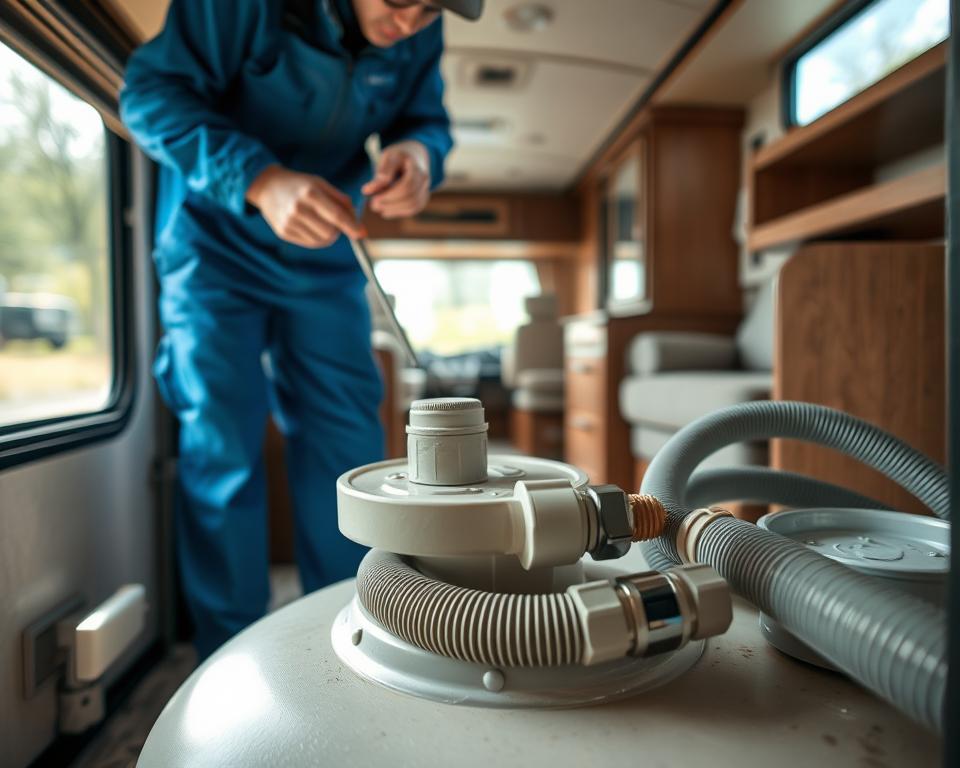RV Septic Tank Pumping: Essential Maintenance Tips
Imagine what happens when you ignore your RV’s sewer setup. Many RV owners find the idea of septic tank pumping daunting. However, understanding these upkeep steps is essential. These steps preserve your camping joy and avoid expensive repairs. Learning proper waste disposal is key to your septic health. We’ll share vital insights on mobile RV septic pumping near me, including best practices and tips to keep your system running smoothly.
The Basics of Your RV Sewage System
Your RV includes tanks designed for different wastes. The system comprises a black water tank (toilet), a gray water tank (sinks/showers), and a fresh water tank. Knowing these components prevents clogs and ensures efficient cleaning.
Drains and vents manage liquid and air movement throughout the system. Understanding this synergy helps you avoid blockages and buildup. This knowledge ensures hassle-free trips and reliable waste handling.
Regular checks and care keep your tanks in top shape. Frequently checking tank levels and emptying on time preserves comfort. By maintaining your RV’s septic system properly, you’ll improve its lifespan and enjoy every trip more.
Why Routine Tank Pumping Matters
Routine sewage draining preserves functionality and hygiene. Waste buildup triggers odors and backups that ruin outings. Overfilled tanks risk ugly overflows. Such mishaps kill the fun on the road.
Skipping pump-outs leads to pricey repairs. Damage from neglect can shorten component lifespan. Regular pumping ensures seamless operation. You’ll avoid nasty surprises and costly breakdowns.
Staying on top of maintenance wards off backups. Dedicating effort to pumping reflects good RV stewardship. It greatly improves your travel experience. A strict pumping routine lets you enjoy camping without septic concerns.
Finding the Right Dump Frequency
Determining dump intervals needs careful thought. Generally, dump every 3–5 days when in use. Still, it varies with tank size and occupancy. Pinpointing the correct dump time is key for effective wastewater management.
Empty once the black tank reaches roughly 66% full. It ensures good drainage and cuts down on odors. Ignoring it can cause backups and unpleasant odors.
Many elements can affect how often you pump:
- Number of people on board
- Length of stay
- Type of waste generated
- Tank capacity
Scheduling prevents on-the-road crises. Remember portable toilet service schedules. Tracking your usage helps forecast dump needs.
| Usage Scenario | Pumping Frequency |
|---|---|
| Weekend Getaway (2 people) | Every 3–4 days |
| Extended Trip (4–6 people) | Every 2–3 days |
| Seasonal Living (2–4 people) | Weekly or Bi-Weekly |
Keep a close eye on tank levels and your habits. Staying attentive guarantees a pleasant trip.

Best Practices for Dumping Your Tanks
Proper methods stop odors, clogs, and expensive repairs. Always empty the black tank first to protect the gray tank. This prevents dirty water from fouling the clean.
Using a high-quality hose minimizes leaks and ensures smooth dumping. Tighten connections to stop spills. After emptying, flush the black tank with plenty of water. This removes residue and preps the tank for next time.
Scout dump spots along your route. This preparation streamlines your dump routine.
In short, follow these key steps for efficient dumping:
- Empty the black water tank first.
- Use a top-quality sewer hose.
- Flush the black tank thoroughly after emptying.
- Plan your dump station locations.
Following these guidelines simplifies black tank maintenance.
Proper Use and Maintenance of Your RV Tanks
Grasping correct handling of black and gray tanks ensures system health. Maintain a bit of water in the black tank to aid waste decomposition.
Don’t flush wipes, feminine products, or paper towels. Use only RV-compatible paper. Regular checks spot leaks or cracks before they worsen.
Adding treatments now and then improves septic service. They introduce microbes that digest solids effectively. Simple steps ensure smooth tank operation.
- Check for leaks and damage often.
- Apply RV-specific chemical treatments.
- Keep vents clear to avoid odors.
Adhering to these practices safeguards your system. You’ll enjoy more worry-free trips.
RV Septic Tank Pumping: Key Tips for Success
To pump your tank effectively, follow a methodical approach. It’s essential to use designated dump stations. Know your tank’s capacity to avoid overflows.
Check tank indicators regularly to time pump-outs. Routine scheduling preserves your septic system and travel enjoyment. Setting a dumping schedule improves system efficiency.
Flush well after every emptying. It ensures each dump is cleaner than the last. By applying these strategies, you’ll maintain your RV’s condition and comfort.
Common Mistakes to Avoid When Maintaining Your RV Septic System
Upkeep prevents trip interruptions. Not using enough water in the black tank leads to buildup. Adequate water use breaks down solids efficiently.
Wrong flushables cause havoc—never flush wipes or towels. Only biodegradable RV-safe items belong in the black tank. They cause backups and costly service calls.
Keep the black tank valve closed until ready to dump. Open valves let water out but hold solids, causing residue. Only open when ready to empty for a complete clean.
Awareness of these errors boosts system longevity. Avoiding them keeps your waste management reliable.
When to Seek Professional Septic Services
Recognizing the need for expert help extends tank life. Persistent odors often indicate complex issues. Tanks that empty sluggishly hint at internal blockages.
Visible residue at dump points requires attention. Such situations usually need high-pressure cleaning. Experts use specialized tools to clear stubborn clogs.
Regular expert check-ups safeguard tank health. Acting on findings quickly prevents bigger problems. Professional service ensures proper functionality.
Ongoing Septic Care Tips
Long-term strategies sustain wastewater efficiency. Scheduled dumps preserve longevity and operation. Routine rinses clear residue and stave off expensive breakdowns.
Implementing clean cycles safeguards tank health. Inspecting connections stops leaks before they spread. Opting for biodegradable products protects plumbing.
Consider these long-term practices:
- Stick to a pump-out timetable.
- Rinse often to remove solids.
- Sanitize twice a year.
- Inspect parts frequently for wear and tear.
Proactive care delivers worry-free travel. Routine service lets you focus on the scenery, not your sewer.
Wrapping It Up
Good septic care ensures enjoyable trips. Knowing system function and cleaning steps stops issues. Routine black tank dumping boosts performance. This makes your journey more comfortable.
Consistent inspections and care deliver trouble-free trips. This reliability supports every outing. Adopting these habits keeps your RV ready to roll. Thus, you can concentrate on adventures rather than septic concerns.
